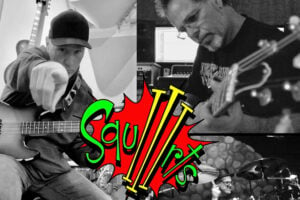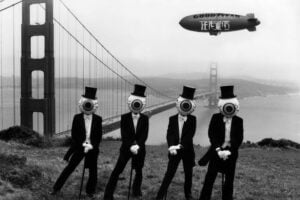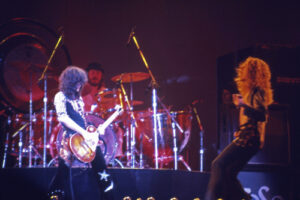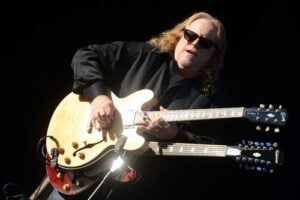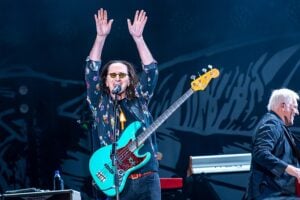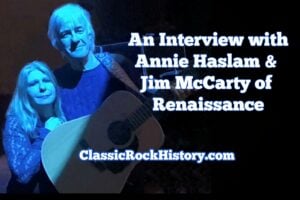Since forming in the 1960s, mystery and intrigue have surrounded The Residents. Wild claims that everyone from George Harrison to Les Claypool has been a member over the years have cropped up.
But the truth is that, save for Hardy Fox, who, before his 2018 death, identified himself as a co-founder and primary composer, no one truly knows the identities of The Residents. But that, along with the fact that the band’s debut, 1974’s Meet the Residents, parodied The Beatles, hasn’t stopped the wild rumors from persisting.
Making matters murkier, the band notoriously doesn’t do interviews, leaving Homer Flynn, a founding member and the band’s main graphic designer and art director, to be The Residents’ one and only mouthpiece. “The primary personality trait common to The Residents is low to no ego,” Flynn tells ClassicRockHistory.com.
He adds: “The Residents love rumors and innuendo. Consequently, they are delighted by the idea that George Harrison, Les Claypool, Mark Mothersbaugh, Donald Trump, and Jesus are members of the group.”
To that end, over the years, the group has had many laughs at all the speculation, which brings us back to the ever-persistent Beatles connection. “The wildest rumor, of course, is that The Residents are The Beatles in Disguise,” Flynn laughs.
The Residents have plans to perform their 1979 album Eskimo in full for the first time ever on tour in 2026. The experience, as always, will be immersive and shrouded in the same mystique that made fans fall in love with The Residents back in the day.
Beyond that, Flynn says The Residents will carry on as they always have, with “mythology, love, and the illusion of infinite creativity.”
Give us the rundown on the tour that will feature a full playthrough of Eskimo.
The Residents’ Eskimo tour started when they were asked to close an event called A Night of Ideas at the SF Public Library in March 2024. One of the more inviting elements of this event was the fact that the organizers only wanted a 20-minute performance, which, as far as The Residents were concerned, was an open door to experimentation.
In the past, they felt that the Eskimo album demanded a fully funded and produced stage show, and while there was a lot of interest over the years, nothing was up to their standards. But, what the heck, they decided, “Let’s play around with it.”
From The Residents’ perspective, the resulting performance was not only satisfying, it came together more effortlessly than anything they had ever done. So, they decided to see where it wanted to go.
Why is Eskimo important, and what can you tell us about its creation?
The primary idea or concept behind Eskimo was to create an album that told stories with sound; music would only be one of the sounds, and certainly not the most important. As far as The Residents were concerned, wind was just as important a part of Eskimo as music.
Given that mandate, they experimented with marginal success for three and a half years until their ideas somehow came together, and the final album was recorded over a six-month period.
Have you taken a step back to assess the legacy and impact of Eskimo?
In regards to Eskimo’s legacy, the most important thing in my mind is that people still care about and want to hear it performed live over forty years after the album’s initial release. It stands alone, both in the culture overall and in The Residents’ vast output, which makes it a unique and singular work. There’s still nothing else quite like it.
And what about The Residents? There’s a lot of mystery around the band.
Judging the importance of a band that most people have never heard of is tricky. They have no hits – their biggest selling item is a T-shirt (talk about pop culture). I just spent ten minutes searching Google for “faceless bands,” and while there were countless references to Daft Punk, Slipknot, Gwar, Kiss, and many more, there was nothing about The Residents until, as I was about to give up, I searched for “1970s Faceless Bands” and they finally popped up.
Ultimately, I can only judge their importance as a product of their commitment to imagination and creativity. They certainly don’t have millions of followers, but there is always a new audience for an entity more motivated by artistry than ego-driven fame. They offer something no one else does.
For those that don’t know, how did The Residents form, and what was the objective?
The Residents have always been huge music fans, and in the late ‘60s, they loved the eclectic sounds of hippie era bands like the Jefferson Airplane, Country Joe and the Fish, The Youngbloods, Jimi Hendrix, The Quicksilver Messenger Service, and many more.
They saw it as an era of creative risk-taking and discovery, but saw that, once these bands found their formulas for commercial success, their days of experimentation were over. At first, the then-unnamed group was disappointed, but ultimately saw it as an opportunity, an open door they were thrilled to run screaming through.
Was the plan always to be elusive and anonymous, or was that something that happened over time to give the band notoriety?
The plan was to focus on originality and creativity. Being music fans, The Residents saw how the members of other groups often prized individual attention and stardom over originality. They felt that the combined creative power of an ensemble far outweighed the strength of its individuals – the group was more important than the sum of its parts.
The idea of anonymity not only protected this group identity, it also provided a buffer from the quagmire of celebrity, if indeed they ever became famous. But they also quickly realized the mystique and promotional value inherent in their faceless pose.
How hard has it been to maintain the secrecy around the members? Have you had many close calls?
The ultimate secret to protecting their identities came from drawing the circle enclosing and protecting the group large enough for others to feel included in a secret world; consequently, revealing The Residents’ identities became a betrayal, not only of the group but of themselves. It’s a matter of trust, and by trusting others, their friends and cohorts became parts of a hidden whole that they admired.
Do you ever see a time when the band’s identities will come out? As for the ones who have come out, were you okay with that?
Personally, I don’t see their identities ever being revealed, but since The Residents are more spirit than flesh, their future is infinite. As for those who have succumbed to the demands of ego and recognition and “come out,” The Residents, as well as myself, can only feel sorry for them.
Check out similar articles on ClassicRockHistory.com Just click on any of the links below……
Read More: Artists’ Interviews Directory At ClassicRockHistory.com
Read More: Classic Rock Bands List And Directory










